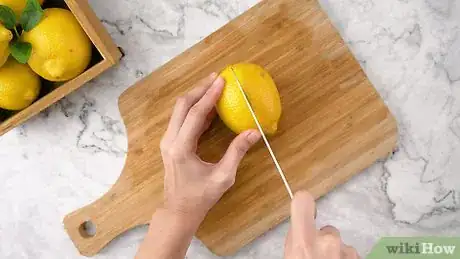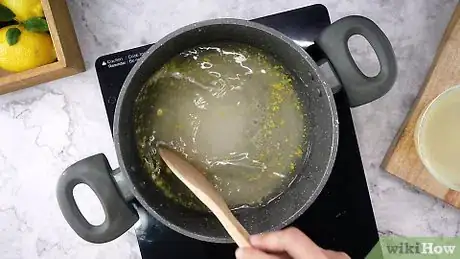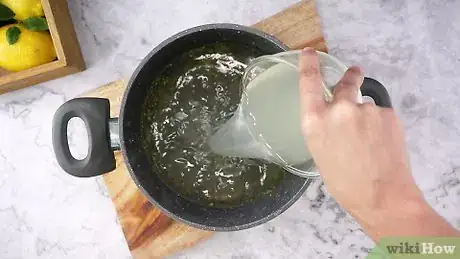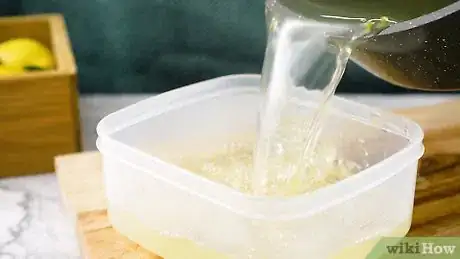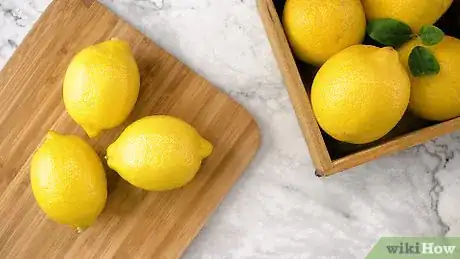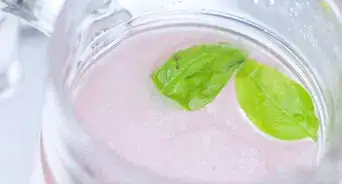This article was co-authored by wikiHow Staff. Our trained team of editors and researchers validate articles for accuracy and comprehensiveness. wikiHow's Content Management Team carefully monitors the work from our editorial staff to ensure that each article is backed by trusted research and meets our high quality standards.
There are 11 references cited in this article, which can be found at the bottom of the page.
The wikiHow Video Team also followed the article's instructions and verified that they work.
This article has been viewed 587,450 times.
Learn more...
Lemon juice is valuable to stock for cooking, cleaning, or even drinking. It can be taken to remedy coughs and sore throats or mixed into lemonade. The best part of this versatile juice is that a fresh batch is easy to make at home with some ripe lemons. To get plain juice, all you have to do is cut open the lemons and squeeze them dry. Freshly-squeezed juice won’t last very long, but you could mix it with boiled sugar to create a syrup that is easy to preserve and use for cooking. Once you taste what you have created, you won’t ever need to buy lemon juice from the store again.
Ingredients
- 6 lemons
- 6 teaspoons (24 grams) of sugar (optional)
- 6 cups (1.4 L) of water (optional)
- 6 lemons
- 1 tablespoon of lemon zest
- 5 cups (1.2 L) of water
- 2 cups (400 grams) of sugar
Steps
Squeezing Lemon Juice
-
1Cut the lemons lengthwise in half with a sharp knife. Most people cut across the width of a lemon. Instead of doing that, make a vertical cut down the center of each lemon. It makes the lemon halves easier to squeeze, allowing you to get a little more juice out of them. [1]
Each lemon will produce 1⁄4 to 1⁄3 cup (59 to 79 mL) of juice.
-
2Squeeze the juice out into a bowl if you’re doing it by hand. Place the bowl on a countertop and juice the lemon halves into it one at a time. Most of the juice will flood out after a gentle squeeze. After the juice stops flowing, apply more pressure to wring out the remaining drops. Finish by poking the cut part of the lemon with a fork and twisting to remove any remaining juice.[2]
- Filter out the seeds by holding a strainer over the bowl as you squeeze each lemon half. Otherwise, you will need to pick out the seeds and bits of pulp that fall into the bowl.
Advertisement -
3Crush the lemon in a citrus press as an alternative. Position the lemon with the cut side down. Press the handles together to crush the juice out. If you have a round juicer, push the cut end of the lemon onto the plastic spike in the center. Spin the lemon back and forth while pushing down on it.[3]
- A citrus press is the easier type of juicer to use. The spinning press can lead to pith in the juice, so filter it over a strainer if you wish to remove it.
-
4Put the lemon in an electric juicer if you don’t mind pulp. Electric juicers are similar to the spiked manual ones. Push the cut end of the lemon onto the spike in the center, then turn on the juicer. The spike rotates to make as much juice as possible. The only downside is that it also cuts up the pith you may not want in your juice.[4]
- If you need to remove the pith, you can pour the juice through a strainer.
- Some blenders and stand mixers have juicer attachments. Connect the attachment to your device for a quick way to create lemon juice!
-
5Mix water or sugar into the juice if it tastes too sour. The juice is finished once you’re done squeezing, especially if you used big, juicy lemons that aren’t very acidic. Taste the juice to see if it’s the way you want it. If it seems too strong, mix in about 1 teaspoon (4 grams) of sugar for each lemon you used. You could also add up to 1 cup (240 mL) of water per lemon to dilute the juice.[5]
- Sugar and water make the juice much easier to drink or cook with, especially if it tastes very tart or acidic. Keep in mind that the juiciest varieties, such as Meyer lemons, already have a unique, sweet taste that could be ruined if you plan on using the juice to flavor food.
- To avoid changing the juice’s flavor too much, add the sugar or water in small amounts. Taste the juice each time.
-
6Store the juice in the refrigerator for up to 3 days. Pour the juice into a resealable container labeled with today’s date. It will turn bitter after that, so freeze it if you don’t plan on using it right away. The juice will retain its quality for up to 4 months after freezing it.[6]
- Lemon juice doesn’t spoil. It is safe to drink after 3 days in the refrigerator, but it won’t taste very good. It also lasts indefinitely in the freezer but loses quality over time.
- To thaw frozen juice, let it sit at room temperature for up to an hour. You can also warm it in the microwave at a low temperature.
Creating a Preservable Lemon Syrup
-
1Juice 6 lemons into a small glass or bowl. Freeze, then microwave and roll the lemons around to free more of the juice. After cutting the lemons in half lengthwise, squeeze out as much of the juice as you can get. Use a fork or a citrus juicer to get more out of each lemon. You will end up with about 1 3⁄4 cups (410 mL) of fresh juice.[7]
- Cut up additional lemons if you need more juice. Each lemon will give you 1⁄4 to 1⁄3 cup (59 to 79 mL) of juice.
-
2Grate a fresh lemon peel to add to a stovetop pot. You will need about 1 tablespoon (6 grams) of lemon zest. It’s easy to make by rubbing the skin from one of the lemon halves over a grater, microplane, or another tool. Keep it separate from the lemon juice. Put it in a pot that is safe to use on the stove.[8]
- The zest is the lemon’s skin. Be careful to avoid adding the white pith underneath it. The pith is bitter and can affect the juice’s flavor.
- The zest isn’t essential. It adds a stronger lemon flavor to the juice, but you can skip it if you aren’t able to get any.
-
3Combine water and sugar with the lemon zest. Pour about 1 cup (0.24 L) of water into the stovetop pot with the lemon zest. Then, mix in 2 cups (400 g) of sugar. If you like your lemon juice sweeter, add another 1/4 cup (50 g) of sugar.[9]
-
4Heat the pot over medium heat until the water starts to simmer. Turn the stove on and wait for the water to heat up. When it begins simmering, it will reach about 185 °F (85 °C). It will also start to steam and release bubbles every second.[10]
- If you don’t wish to juice the lemons in advance, take advantage of the time spent waiting for the water to heat up. Just be sure to keep an eye on the pot so it doesn’t boil over!
-
5Cook and stir the water for 4 minutes until the sugar dissolves. Get a spoon or spatula and gently swirl the water around. Watch for the sugar to disappear into the water. Once you are no longer able to see the sugar, set the pot aside.[11]
- Remember to turn the stove burner off after moving the pot off of the heat.
- The mixture will form a lemon-flavored syrup you can use to flavor drinks or freeze to make lemonade.
-
6Pour the lemon juice into the pot. Add the fresh lemon juice and stir the liquid around to combine it. Make sure it is well-mixed, then taste test it once it cools. Your lemon syrup is ready! Mix in 4 cups (0.95 L) of lukewarm water as well if you want to make lemonade.[12]
- If you’re planning on using the syrup some other time, store it in a sterilized canning jar.
-
7Put the juice into the refrigerator or freezer until it is cold. Put the juice into a resealable container labeled with today’s date if you don’t plan on using it right away. It will last about 3 days in the refrigerator before it starts losing its flavor. For an alternative storage method, freeze it for up to 4 months.[13]
- This kind of juice is basically lemonade with a homemade syrup. It’s better for drinking than cooking.
-
8Drink or use the juice after it has had a chance to chill. After mixing in the additional water, you can enjoy the juice as a refreshing drink within about 30 minutes. For lemon syrup fresh off the stove, use it as soon as you need it for a recipe. It can be drizzled onto a cake, added to pan-fried fish, or mixed into smoothies and other drinks, for example.[14]
- Lemon juice is often used when marinating fish or meat. The acid causes the food to absorb more flavor.
Selecting and Storing Lemons
-
1Choose heavy varieties of lemons to get more juice out of them. Meyer lemons produce a ton of juice, but Fino, Lapithkiotiki, or Primofiori are a few other options. Meyer lemons are fairly sweet, so you could choose another type if you want a tart taste. These varieties are all smaller than regular grocery store lemons but feel heavy for their size. Pick up the lemons to test their weight. Set aside the heaviest ones for juice.
- Eureka and Lisbon lemons are the regular lemons you will commonly find year-round at stores. They are larger and paler than Meyer lemons but also very tart. Add sugar and water to the lemon juice if you want a sweeter flavor.
-
2Pick lemons that feel soft but not mushy. Hold the lemons and squeeze them gently between your fingers. Soft lemons already have plenty of juice and will be ready for use as soon as you get home. The lemons should also have smooth skin with a deep yellow color.
- Lemons that feel mushy have already spoiled and should be avoided. Also, avoid lemons that feel hard or look shriveled.
- Lemons with light or green skin tend to be more acidic. You can use them if you want, but ripe lemons are usually better for juice.
-
3Freeze the lemons until you’re ready to juice them. Put the lemons into a resealable plastic bag. Push as much air out of the bag as you can before closing and storing it. The lemons become much easier to squeeze after they have spent some time in the freezer. It’s also a good way to save some juicy lemons to use whenever you need them throughout the year.
- Lemons don’t spoil in the freezer. Instead, they dry up over time. Use them within 3 months for optimum quality.
-
4Thaw the lemons by microwaving them for about 30 seconds. When you’re ready to use the frozen lemons, take them out of the bag and place them in the microwave. Heat them at a low setting until they reach room temperature. Make sure they feel soft to the touch before attempting to juice them.
- You could also put the lemons in a bowl of warm water until they feel soft to the touch.
-
5Press and roll the lemons on a cutting board to free more of the juice. Set the lemons down on a flat surface, then push down on them with a firm amount of pressure. Move them around like you’re pushing a rolling pin or kneading dough. Roll each lemon for 1 or 2 minutes until it feels very soft and pliable. That means the membranes inside the lemons have broken and released juices.[15]
- To avoid getting lemon juice on your cutting board, cover it with a paper towel or roll the lemons on a covered countertop instead.
- If you don’t want to roll the lemons, you could also puncture them a few times with a sharp knife or peel them. These options are much messier than rolling them, however.
- If you have a citrus juicer, you can skip rolling the lemons. Juicers are efficient enough to remove all of the juice without the extra help!
Community Q&A
-
QuestionHow long before lemon juice goes bad?
 AnonymousSuperWriterCommunity AnswerLemon juice will last for a few to several days if it is in the refrigerator.
AnonymousSuperWriterCommunity AnswerLemon juice will last for a few to several days if it is in the refrigerator. -
QuestionCan I drink lemon juice if I have a stomachache?
 Community AnswerNo. Lemons are acidic, and it might make your stomach feel worse.
Community AnswerNo. Lemons are acidic, and it might make your stomach feel worse. -
QuestionWhat is the best time to drink lemon juice?
 Community AnswerMost people will drink a warm cup of lemon juice or lemon water upon waking up but before eating anything in order to "wake up" their digestive systems. Others might feel more comfortable drinking it before bed as a warm night-time drink.
Community AnswerMost people will drink a warm cup of lemon juice or lemon water upon waking up but before eating anything in order to "wake up" their digestive systems. Others might feel more comfortable drinking it before bed as a warm night-time drink.
Warnings
- Handle knives carefully on a stable surface to avoid cutting yourself. Lemon juice causes broken skin to sting a lot, so consider wearing rubber gloves if you’re dealing with any fresh wounds.⧼thumbs_response⧽
Things You'll Need
Squeezing Lemon Juice
- Cutting board
- Sharp knife
- Bowl or glass
- Mixing spoon
- Resealable storage container
Creating a Preservable Lemon Syrup
- Cutting board
- Sharp knife
- Bowl or glass
- Stove
- Pot
- Mixing spoon
- Resealable storage container
Selecting and Storing Lemons
- Freezer bag
- Cutting board
- Paper towels
References
- ↑ https://www.epicurious.com/expert-advice/trick-to-juice-lemons-article
- ↑ https://www.farmflavor.com/at-home/how-to-make-lemon-juice/
- ↑ https://www.countryliving.com/food-drinks/a43942/best-way-to-use-lemon-juicer/
- ↑ https://www.foodabovegold.com/citrus-juicers-guide/
- ↑ https://www.farmflavor.com/at-home/how-to-make-lemon-juice/
- ↑ https://stilltasty.com/fooditems/index/17533
- ↑ https://www.createdby-diane.com/2016/01/lemon-syrup.html
- ↑ https://www.tasteofhome.com/article/how-to-make-lemonade/
- ↑ https://www.tasteofhome.com/article/how-to-make-lemonade/
- ↑ https://www.simplyrecipes.com/recipes/perfect_lemonade/
- ↑ https://www.simplyrecipes.com/recipes/perfect_lemonade/
- ↑ https://www.tasteofhome.com/article/how-to-make-lemonade/
- ↑ https://stilltasty.com/fooditems/index/17533
- ↑ https://www.createdby-diane.com/2016/01/lemon-syrup.html
- ↑ https://www.deliciousmeetshealthy.com/homemade-lemonade-recipe/
- ↑ https://thecookful.com/10-mix-ins-make-lemonade-pop/
- ↑ https://living.thebump.com/substitutes-lemon-juice-cooking-8754.html
About This Article
To make lemon juice, you’ll need about 1 lemon for every ¼ cup (60 mL) of lemon juice you want to make. Start by cutting your lemons in half lengthwise with a knife. Place a strainer over a bowl and squeeze the halves over it with your hands to get the juice out. The strainer will catch any seeds and bits of pulp. Wring out as much juice as you can by hand. Then, poke the cut part of the lemon with a fork and twist to squeeze out any leftover juice. If your lemon juice tastes too sour, try mixing in 1 teaspoon (4 grams) of sugar for each lemon you used. Alternatively, add water to dilute the lemon juice. Transfer the juice to a sealable container and store it in the fridge for up to 3 days or the freezer for up to 4 months. To learn how to make sweetened lemon juice, read on!
